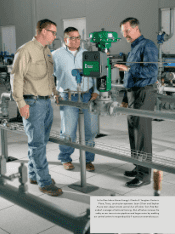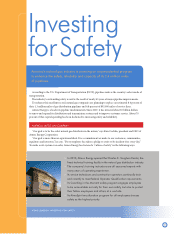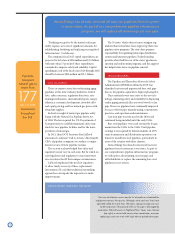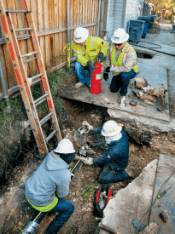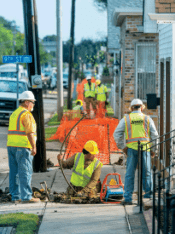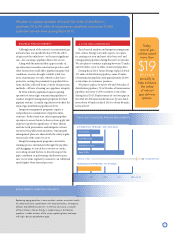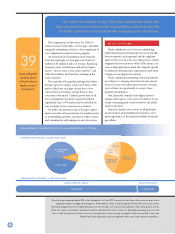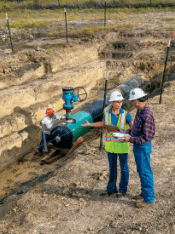Atmos Energy 2014 Annual Report Download - page 14
Download and view the complete annual report
Please find page 14 of the 2014 Atmos Energy annual report below. You can navigate through the pages in the report by either clicking on the pages listed below, or by using the keyword search tool below to find specific information within the annual report.
Natural gas is
the foundation
fuel of our
economy
and meets
PERCENT
of the nation’s
energy needs
today.
27
Atmos Energy’s pipeline infrastructure investments are occurring at
an opportune time. Financing costs for both debt and equity have been
favorable. And, the cost of natural gas has remained relatively low.
12
FUELING THE FUTURE
Natural gas is the essential fuel to achieve key
environmental goals of fewer pollutants and cleaner
air. For this reason, major environmental groups
support using more natural gas, especially to replace
coal for generating electricity.
Approximately 28 percent of the electricity in the
United States today is generated at 1,700 natural gas-
red power plants. Virtually all new power plants
built during the past decade use natural gas for fuel
because of its abundant domestic supply, low cost
and low emissions.
With the rapid retirements of many coal-red
power plants, natural gas is becoming the country’s
foundation fuel source as well as the backup fuel to
complement renewables development. To supply
more gas-red power plants, new natural gas pipe-
lines and greater capacity on existing transmission
lines are needed.
e U.S. Energy Information Administration
projects that total natural gas consumption in the
United States will grow from 25 trillion cubic feet
(Tcf) a year today to 30 Tcf by 2040. is growth will
be caused by the increased use of gas
both to generate electricity and to fuel
manufacturing and process industries.
In 2013, for example, Mississippi
regulators adopted a policy to en-
courage more expansion of the state’s
natural gas infrastructure to attract
industrial investment and to promote
economic development. e state’s
Public Service Commission approved
a Supplemental Growth Rider that
allows Atmos Energy to spend up to $5 million a
year on infrastructure expansions to support new
industrial projects and added jobs.
Historically, it has been dicult to justify extend-
ing natural gas pipelines to certain industrial projects
because the initial expected gas volumes and reve-
nues were insucient to pay for the investment. is
new Mississippi program funds gas infrastructure
investments for their rst 10 years in service. Any
new gas revenues generated by the investments will
help recoup the cost of the program, which is being
paid for by customers in Mississippi.
ADVANTAGEOUS TIMING
Atmos Energy’s pipeline infrastructure in-
vestments are occurring at an opportune time.
Financing costs for both debt and equity have been
favorable. And, the cost of natural gas has remained
relatively low.
Because of extremely low interest rates, issu-
ing debt has been very attractive for companies,
like Atmos Energy, that must raise hundreds of
millions of dollars of new capital each year. e
company has taken advantage of this opportunity
not only to renance its debt issues at lower prices,
but also to lock in a portion of the interest rate on
future debt renancings.
At the same time, investors have expressed strong
condence in Atmos Energy’s stock. Accordingly,
the market price of Atmos Energy shares has risen
during the period from October 1, 2010, to October
1, 2014, at a compounded average growth rate of
approximately 13 percent a year.
Atmos Energy has issued more than 10.2 million
shares of common stock during the past four scal
years to raise additional capital and to keep its
debt-to-capitalization ratio in balance.
Brad McDaniel, senior service technician, reviews drawings of
Atmos Energy’s pipeline supplying gas to the new Yokohama Tire
Company plant at West Point, Mississippi. Now in the first phase of a
four-phase expansion program, the complex eventually will employ
2,000 workers and will exceed 100 acres under roof by 2018.
Working with the Mississippi Public Service Commission, Atmos
Energy secured a special economic development rider to help recover
infrastructure costs that support new industry and jobs for the state.
ATMOS ENERGY: INVESTING FOR SAFETY
CO2
CO2 AND OTHER EMISSIONS ARE MUCH
LESS WITH NATURAL GAS THAN WITH COAL
Source: American Clean Skies Foundation
COAL
227,052,854
POUNDS OF CO2 PER YEAR
331,545
POUNDS OF NOX PER YEAR
740,450
POUNDS OF SO2 PER YEAR
NATURAL GAS
91,743,152
POUNDS OF CO2 PER YEAR
6,273
POUNDS OF NOX PER YEAR
784
POUNDS OF SO2 PER YEAR


